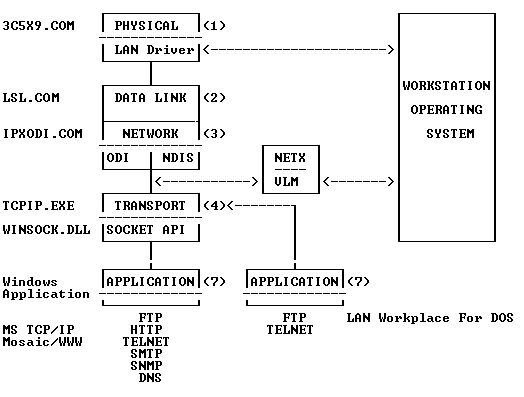| RETURN | LANs and Novell |
The OSI Model and NetWare
The following represents a breakdown of the Open Systems Interconnection (OSI) model as it applies to a typical Novell LAN environment.
Layer 1 Physical Ethernet Module LAN Driver (3C5X9.COM)
Layer 2 Data Link Link Support Layer LSL.COM
Layer 3 Network IP/IPX IPXODI.COM
Layer 4 Transport TCP TCPIP.EXE
Layer 5 Session Not used
Layer 6 Presentation Not used
Layer 7 Application FTP/TELNET/HTTP/SMTP/etc Windows Applications
Interoperability between layers is depicted in the illustration below and the following paragraphs:

The implementation of Novell’s LAN architecture does not exactly follow the OSI model (but whose does?). However, the diagram above CONCEPTUALLY illustrates the breakdown of Novell LAN tasks and interoperable layers and the access points in the LAN architecture.
How it all works together!
Link Support Layer (LSL)
LSL.COM is VENDOR-SPECIFIC. LSL stands for Link Support Layer and is proprietary to Novell. LSL is loaded from the initial DOS prompt, making its services available to all subsequent DOS and Windows functions. LSL looks at the NET.CFG file (in the same directory as LSL.COM) and sets up buffers in accordance with programming in the NET.CFG file (in the Link Support section).
LAN Driver Boards/Modules
Next, the Ethernet LAN driver is loaded. Usually, in Clearwater this will be the 3COM driver, 3C5X9.COM, or the SMCPLUS driver from Standard Microsystems Corporation. This driver is VENDOR-SPECIFIC and will have tight program hooks to the individual LAN system as well as the Operating System in the end user’s workstation, forming a Network Operating System (NOS). The 3C5X9.COM driver will get the hardware operating requirements (Base I/O address, Interrupt Number, Interrupt Rate (to ensure that enough interrupts are available to support high speed serial ports), transceiver type, etc. from a configuration file, 3C5X9.SET.
IPXODI
Finally, the IPXODI (Inter-Packet EXchange, Open Datalink Interface) driver is loaded. This is VENDOR-SPECIFIC, and is provided by the LAN vendor. In the Novell LAN environment, this is the IPXODI.COM driver from Novell. IPXODI does most of the work in providing the different Ethernet Frames required for Novell and standard protocol stack operations. At this layer, standard interfaces exist to facilitate connection to upper layer protocols that might be provided by different vendors. These Operating System-specific interfaces include Novell’s Open Datalink Interface (ODI) or Microsoft’s Network Driver Interface Specification (NDIS, NDIS2, NDIS3) specifications. When using the NDIS specification , be sure to keep in mind that there are different revisions of the NDIS specifications. Novell for instance, supplies a supplemental driver for ODI that can allow NDIS2 protocols to operate on top of it (ODINSUP.COM). Microsoft can support NDIS3 protocols with their MSODISUP.386 series of VxDs (Virtual Device Drivers).
TCP/IP
TCP/IP operates at the OSI Layer 4, Transport Layer. In the Clearwater LAN environment, the Novell TCPIP.EXE program is loaded under DOS. As such, it will support ONLY THOSE DOS PROGRAMS WRITTEN FOR IT! Naturally, Novell’s TCPIP.EXE program will support LAN Workplace for DOS. However, a standard Application Programming Interface (API) has been written by Microsoft that define a “socket” for Windows, known as a WINSOCK Dynamic Link Library (WINSOCK.DLL). Novell’s LAN Workplace For DOS, Version 4.0 and above, include a winsock so that other protocols can make use of TCP/IP as a lower layer transport protocol. Such programs include MOSAIC, NETSCAPE, Microsoft TCP/IP, among others! Of course, winsock is a WINDOWS interface, thus any such TCP/IP-based utilities must operate under the Windows Operating System. Therefore, if problems are encountered running a WINSOCK compatible TCP/IP application, the version of LAN Workplace For DOS and the WINSOCK.DLL should be checked. Also, compatible versions of Novell’s Winsock and its associated library, WLIBSOCK.DLL, must be maintained.